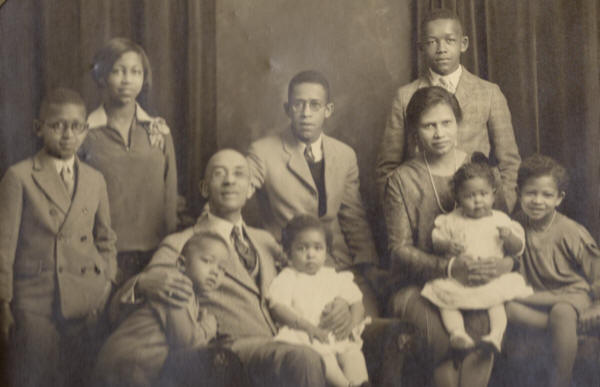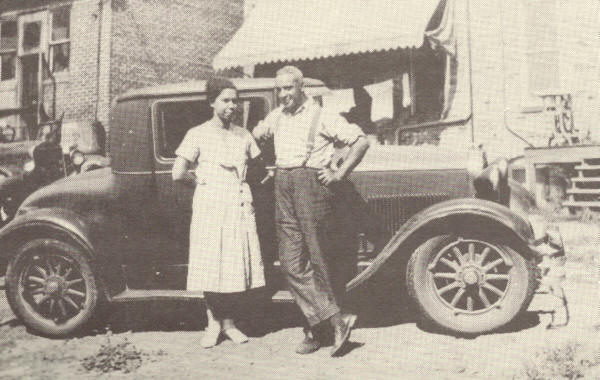
Oscar W. Baker holds two of his eight children in this family photo from the 1940s. Black History Month: Outmoded Vestige of Racism or Justifiable Recognition?
|
||||||||||||
| Printer Friendly Story View |
Cynthia Tucker, columnist for the Atlanta (GA) Constitution newspaper doesn't think we need to observe Black History Month any longer.
"Suffice it to say that the nation of Tiger Woods, Oprah and Barack Obama no longer needs a Black History Month," she wrote recently.
"It's not merely that a short month set aside to commemorate black achievement is a curious and old-fashioned appendage, like rabbit ears on a TV or a rotary dial on a telephone. It's worse than that: The commemoration is a damaging form of apartheid, setting the contributions of black Americans aside as separate and unequal. It sends the wrong signal to all Americans, black, white and brown."
Begging the pardon of the eminent columnist, I think there is still a place for special recognition for African Americans.
Especially in the tri-city area of Bay City, Saginaw and Midland, more awareness of contributions of blacks would serve to insure greater understanding.
For years I covered the annual dinner of the National Association for the Advancement of Colored People in Bay City without delving much into the subject. The main speaker was always a prominent black achiever, a lawyer, general, author or such.
I failed to look about me to the folks at the tables and recognize their heritage: why they are here and who came before them.
Recently, as I continued to study local history, I realized how extensive the connections are between the tri-cities and the black community.
White advocates of racial equality were prominent in our history.
James G. Birney, pioneer Bay Cityan 1842-57, was the first anti-slavery Presidential candidate.
The first president of the village of West Bay City was a former leader of colored troops in the U.S. Civil War.
Among the most famous blacks in Michigan were the Goodridge brothers, photographers in Saginaw.
The Jones family, for whom Jones Road in Hampton Township was named, were early black settlers here, as Marvin Kusmierz has pointed out in his local historical website www.bay-journal.com.
Midland had the Highgate family in the 19th century and Aaron and Caroline Highgate both were graduates of Avery College in Pennsylvania. Freddie Highgate, their son, who lived at 810 Rodd St., became best known for selling plants and shrubbery throughout the county. Although not rich, Freddie was a noted philanthropist, helping the poor with food, fuel and cash for small debts.
John Johnson Sr. came to Midland in 1863 to work in the lumber mills. After serving in the Civil War, he returned to Midland for 68 years until his death. In 1866 he commuted by stagecoach to Saginaw to learn the barbering trade and played guitar and bass in several local orchestras.
Dr. Jeremy W. Kilar, Delta College History professor, has written an article "Black Pioneers in the Michigan Lumber Industry," published in the Journal of Forest History.
"To be sure, the number of blacks in Saginaw, Bay City and Muskegon was not large; the itinerant ebb and flow found many more concentrating in Detroit and other industrial centers of southern Michigan. By 1880, however, there were 300 blacks in Saginaw, approximately 200 in Bay City, and 55 in Muskegon.
Bay City was described in the Michigan Manual of Freedmen's Progress as a community with "a minimum of racial prejudice."
Dr. Kilar commented: "The relative lack of color prejudice and the reality of social interaction encouraged migration and even permitted financial success for a few enterprising Afro-American settlers."
William Q. Atwood, born a slave in Alabama in 1839, became "one of the richest men of any race in the lumber towns," Dr. Kilar wrote.
After escaping slavery and an unsuccessful sojourn to the California gold fields, Atwood became a timber cruiser in the Saginaw Valley, locating timberlands for prospective investors. He often was paid in lands and in 1868 opened a real estate office at Water and Tuscola in East Saginaw. His timber acreage was valued at $85,000 and he opened a sawmill in 1874 that operated until 1888.
John H. Feeny, another black, left the barbering trade in Clare and moved to East Saginaw and worked as a photographer with the Goodridges. Securing several hundred acres of timber, he operated lumber camps and a sawmill about 50 miles west of Saginaw that employed 100 men.
Perhaps the most storied black in this area was James H. Baker, who came to Bay City after the civil war and was a barber, real estate agent, policeman and restaurateur.
One of Baker's eight children was Oscar W. Baker, who as a boy was caught between cars of the Pere Marquette Rail Road and lost his left leg up to the hip. He became a scholar and was graduated from the University of Michigan Law School in 1902. The Baker Law Firm later became Baker & Selby, one of the Saginaw Valley's most noted firms, that continues to this day.
Black History Month began as "Negro History Week," which was created in 1926 by Carter G. Woodson, a noted African American historian, scholar, educator, and publisher. It became a month-long celebration in 1976. The month of February was chosen to coincide with the birthdays of Frederick Douglass and Abraham Lincoln.
On February 12, 2009, the NAACP will mark its 100th anniversary. Spurred by growing racial violence in the early twentieth century, and particularly by race riots in Springfield Illinois in 1908, a group of African American leaders joined together to form a new permanent civil rights organization, the National Association for the Advancement of Colored People (NAACP). February 12, 1909 was chosen because it was the centennial anniversary of the birth of Abraham Lincoln.

| Printer Friendly Story View |
"The BUZZ" - Read Feedback From Readers! |
|
jchowell Says:
On February 09, 2009
at 07:50 PM
I remember the Baker Family from staying with my grandparents (Andrew and Catherine Radigan) on McClellan St. in Bay City. This would have been around 1947 when I was four years old. My grandparents always spoke very highly of the Bakers and were glad to have them as neighbors.
|
|
|

Dave Rogers |
|
|
|
Printer-Friendly Story View
0200 Nd: 04-21-2024 d 4 cpr 0
12/31/2020 P3v3-0200-Ad.cfm
SPONSORED LINKS
12/31/2020 drop ads P3v3-0200-Ad.cfm


